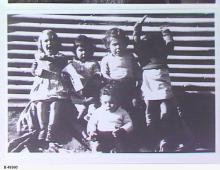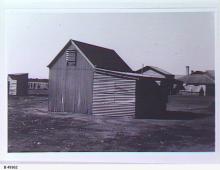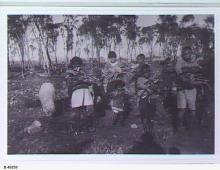Quorn
Information about Colebrook Tji Tji Tjuta, an organisation that was founded by former survivors of Colebrook Home: https://www.findandconnect.gov.au/ref/sa/biogs/SE00141b.htm
A description of Colebrook Blackwood Reconciliation Park that now stands where Colebrook once stood: http://monumentaustralia.org.au/themes/culture/indigenous/display/50688-fountain-of-tears ; More info:
Books, pamphlets and other record at the State Library of South Australia about Colebrook:
http://guides.slsa.sa.gov.au/Aboriginal_Missions/Colebrook
-32.344357, 138.042601The first Aboriginal and Torres Strait Islander children at Colebrook were originally from Oodnadatta Children's Home . These children were moved in order that they could be more easily assimilated far away from their families . The United Aborigines Mission isolated and segregated these children so that 'they could no longer see the natives or hear the sounds of the corroborree'. Over 350 children were taken to Colebrook during its history. After it closed in 1981, former residents formed the Colebrook Tji Tji Tjuta organisation in order to preserve available records of children who had passed through the home. In memorial, a commemorative park now stands on the former site of Colebrook . A statue of a grieving mother is a reminder of the many mothers whose children grew up without them .
0Established by the United Aborigines Mission in 1927, closed in 1981.
Colebrook HomeKaren George and Gay George, Colebrook Home (1927 - 1981) (9 March 2016) Find & Connect, para 2 https://www.findandconnect.gov.au/ref/sa/biogs/SE00138b.htm
Karen George and Gay George, Colebrook Home (1927 - 1981) (9 March 2016) Find & Connect https://www.findandconnect.gov.au/ref/sa/biogs/SE00138b.htm
SAGirrigun Aboriginal Corporation, About Girrigun, Girrigun Aboriginal Corporation
http://girringun.com.au/about
Girrigun Aboriginal Corporation, About Girrigun, Girrigun Aboriginal Corporation
http://girringun.com.au/about
We were all happy together, us kids. We had two very wonderful old ladies that looked after us. It wasn't like an institution really. It was just a big happy family. I can say that about that home - United Aborigines Mission home that was at Quorn. Y'know they gave us good teaching, they encouraged us to be no different to anybody else. We went to the school, public school. There was no difference between white or black.
Confidential evidence 178, South Australia: woman removed with her brother at 5 years in the 1930s; spent approximately 8 years at Colebrook.
Human Rights and Equal Opportunity Commission, Bringing them Home: National Inquiry into the Separation of Aboriginal and Torres Strait islander Children from Their Families (1997)
5 years Confidential evidence 178I remember when my sister come down and visited me and I was reaching out. There was no-one there. I was just reaching out and I could see her standing there and I couldn't tell her that I'd been raped. And I never told anyone for years and years. And I've had this all inside me for years and years and years. I've been sexually abused, harassed, and then finally raped, y'know, and I've never had anyone to talk to about it ... nobody, no father, no mother, no-one. We had no-one to guide us. I felt so isolated, alienated. And I just had no-one. That's why I hit the booze. None of that family bonding, nurturing - nothing. We had nothing (p. 161).
Confidential evidence 248, South Australia: woman removed as a baby in the 1940s to Colebrook; raped at 15 years in a work placement organised by Colebrook.
Unfortunately, the effects of ongoing alcohol and substance abuse contributed to frequent short-lived depressive episodes with suicidal ideation. Her substance abuse was the result of the difficulty she experienced coming to terms with the diagnosis of manic-depressive disorder, her significant family problems and the effects of a childhood where she was dislocated from her family of origin, thus leaving her vulnerable to the events which followed (document provided with confidential evidence 248, South Australia) (p. 168).
Human Rights and Equal Opportunity Commission, Bringing them Home: National Inquiry into the Separation of Aboriginal and Torres Strait islander Children from Their Families (1997)
Birth Confidential evidence 248I remember the beatings and hidings [they] gave us and what I saw. I remember if you played up, especially on a Sunday, you got the cane. You play chasing, you had to drop your pants, lie across the bed and get 3-5 whacks. If you pissed the bed - another 3-5. I remember seeing, when I was about 7 or 9 - I think it was IM get pulled by the hair and her arm twisted behind her back and hit in the face ...
Confidential evidence 251, South Australia: man removed to Colebrook at 2 years in the 1950s.
Human Rights and Equal Opportunity Commission, Bringing them Home: National Inquiry into the Separation of Aboriginal and Torres Strait islander Children from Their Families (1997)
2 years Confidential evidence 2511936 it was. I would have been five. We went visiting Ernabella the day the police came. Our great-uncle Sid was leasing Ernabella from the government at that time so we went there.
We had been playing all together, just a happy community and the air was filled with screams because the police came and mothers tried to hide their children and blacken their children's faces and tried to hide them in caves. We three, Essie, Brenda and me together with our three cousins ... the six of us were put on my old truck and taken to Oodnadatta which was hundreds of miles away and then we got there in the darkness.
My mother had to come with us. She had already lost her eldest daughter down to the Children's Hospital because she had infantile paralysis, polio, and now there was the prospect of losing her three other children, all the children she had. I remember that she came in the truck with us curled up in the foetal position. Who can understand that, the trauma of knowing that you're going to lose all your children? We talk about it from the point of view of our trauma but - our mother - to understand what she went through, I don't think anyone can really understand that.
It was 1936 and we went to the United Aborigines Mission in Oodnadatta. We got there in the dark and then we didn't see our mother again. She just kind of disappeared into the darkness. I've since found out in the intervening years that there was a place they called the natives' camp and obviously my mother would have been whisked to the natives' camp. There was no time given to us to say goodbye to our mothers.
From there we had to learn to eat new food, have our heads shaved. So one day not long after we got there my cousin and I ... we tried to run back to Ernabella. We came across the train. We'd never seen a train before and it frightened the hell out of us with the steam shooting out. So we ran back to the mission because that was the only place of safety that we knew. She was only four and I was only five.
Then we had to learn to sleep in a house. We'd only ever slept in our wilchas and always had the stars there and the embers of the fire and the closeness of the family. And all of a sudden we had high beds and that was very frightening. You just thought you were going to fall out and to be separated. There was a corridor and our cousins were in another room. We'd never been separated before. And the awful part was we had to get into that train later on with one little grey blanket and go down to Colebrook ... a matter of weeks after. From that time until 1968 I didn't see [my mother]. Thirty-two years it was.
[I stayed at Colebrook] till 1946 [when] I was fourteen or fifteen. We were trained to go into people's home and clean and look after other people's children. I went to a doctor and his wife. They were beautiful people. I stayed with them a couple of years.
I guess the most traumatic thing for me is that, though I don't like missionaries being criticised - the only criticism that I have is that you forbad us to our speak our own language and we had no communication with our family. We just seemed to be getting further and further away from our people, we went to Oodnadatta first, then to Quorn next, then when there was a drought there we went to Adelaide and went out to Eden Hills and that's where we stayed till we went out to work and did whatever we had to do.
I realised later how much I'd missed of my culture and how much I'd been devastated. Up until this point of time I can't communicate with my family, can't hold a conversation. I can't go to my uncle and ask him anything because we don't have that language ...
You hear lots and lots of the criticisms of the missionaries but we only learnt from being brought up by missionaries. They took some of that grief away in teaching us another way to overcome the grief and the hurt and the pain and the suffering. So I'm very thankful from that point of view and I believe that nothing comes without a purpose. You knew that in those days there was no possibility of going back because cars were so few and far between and the train took forever to get anywhere so how could a five year old get back to the people.
I guess the government didn't mean it as something bad but our mothers weren't treated as people having feelings. Naturally a mother's got a heart for her children and for them to be taken away, no-one can ever know the heartache. She was still grieving when I met her in 1968.
When me and my little family stood there - my husband and me and my two little children - and all my family was there, there wasn't a word we could say to each other. All the years that you wanted to ask this and ask that, there was no way we could ever regain that. It was like somebody came and stabbed me with a knife. I couldn't communicate with my family because I had no way of communicating with them any longer. Once that language was taken away, we lost a part of that very soul. It meant our culture was gone, our family was gone, everything that was dear to us was gone.
When I finally met [my mother] through an interpreter she said that because my name had been changed she had heard about the other children but she'd never heard about me. And every sun, every morning as the sun came up the whole family would wail. They did that for 32 years until they saw me again. Who can imagine what a mother went through?
But you have to learn to forgive.
Confidential evidence 305, South Australia.
Human Rights and Equal Opportunity Commission, Bringing them Home: National Inquiry into the Separation of Aboriginal and Torres Strait islander Children from Their Families (1997)
5 years Confidential evidence 305 - FionaWe were fortunate because we were just like brothers and sisters in Colebrook. We never ended up in reform. Our brothers and sisters were able to keep ourselves together. Because the Sisters were able to give us the Christian upbringing, we were able to keep some sort of sanity about ourselves. We were brought up very well. I think we had nothing but the best in Colebrook. When you were in Colebrook, the older kids took you on. The two Sisters could not give you the love that a mother could give you but the older one of mine was Emily, that did my hair, she was more than your sister, she was your mother/auntie. The older ones sort of took the younger ones under their care. So you got your love in a different way. Matron couldn't give everybody hugs and loves and kisses, but that minder was more like my mother. There was somebody missing that she took that place as that warm caring person and each one had their older one looking after them.
Confidential evidence 307, South Australia: woman removed at 7 years in the 1930s.
Human Rights and Equal Opportunity Commission, Bringing them Home: National Inquiry into the Separation of Aboriginal and Torres Strait islander Children from Their Families (1997)
7 years Confidential evidence 307
Colebrook Home, ca. 1930: A group of children singing

Colebrook Home, ca. 1930

Colebrook Home, ca. 1930: Children collecting firewood
